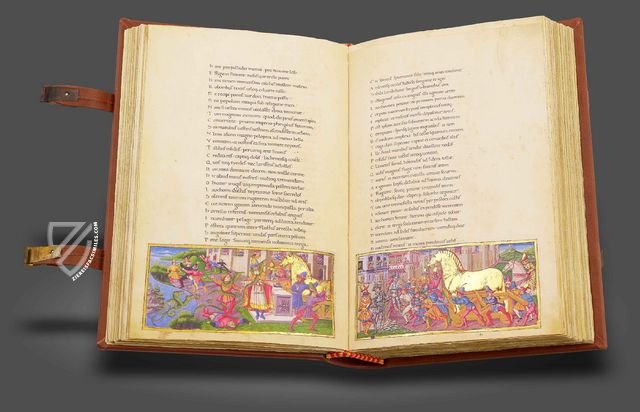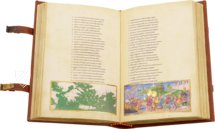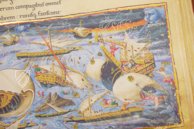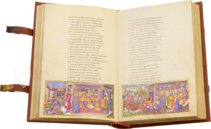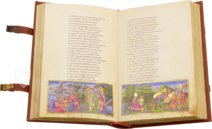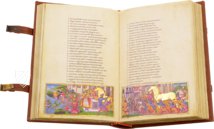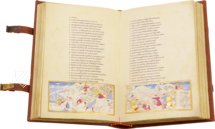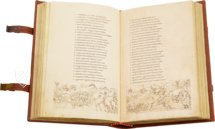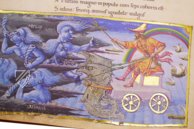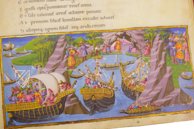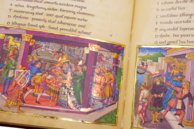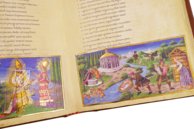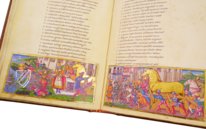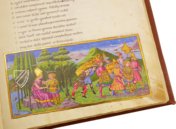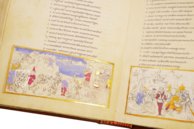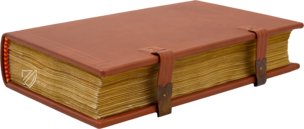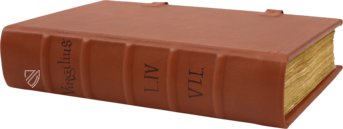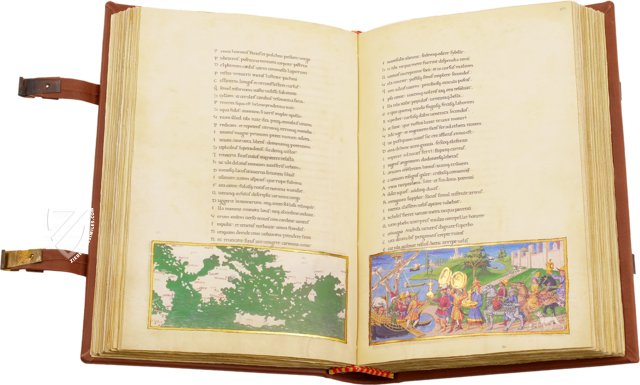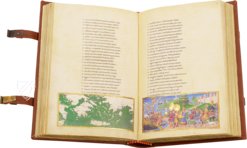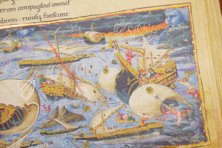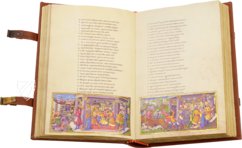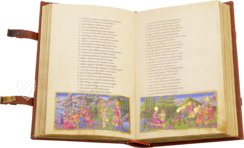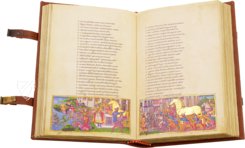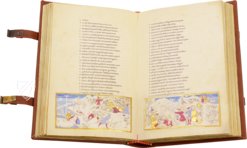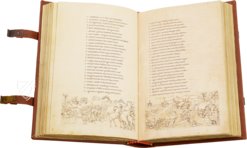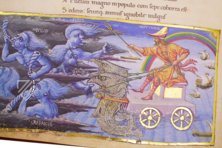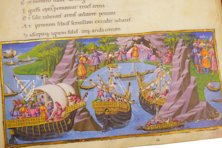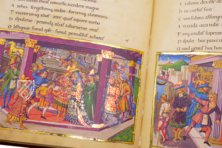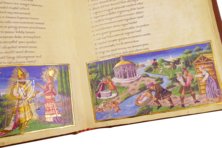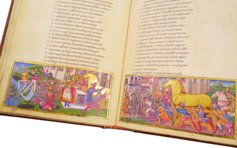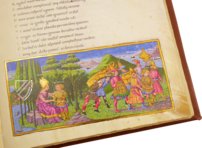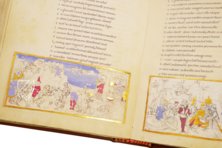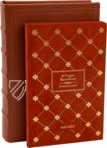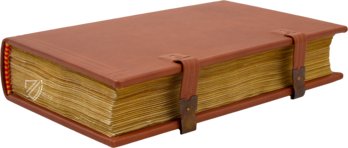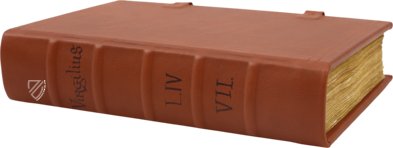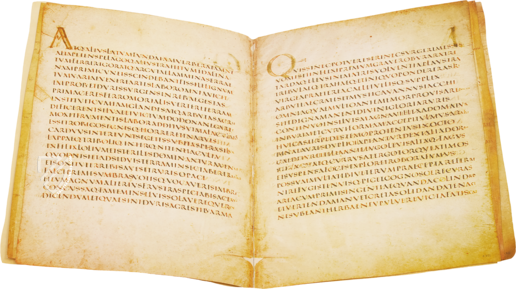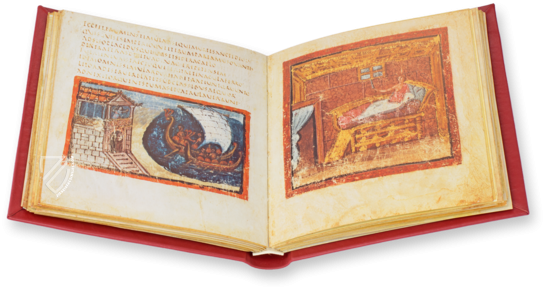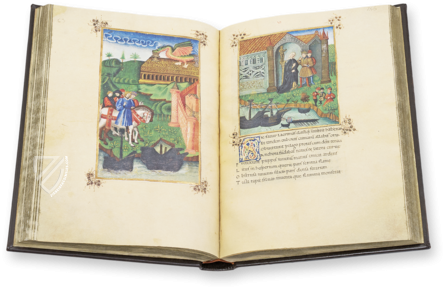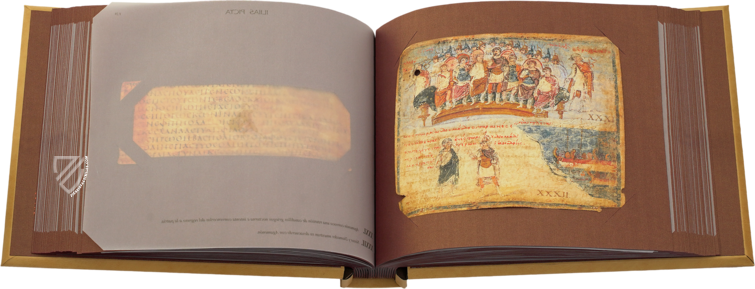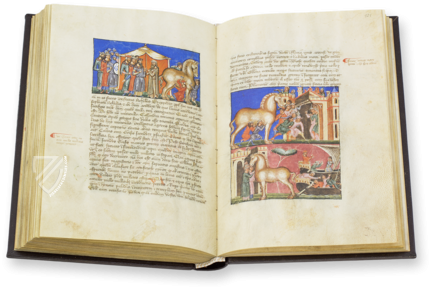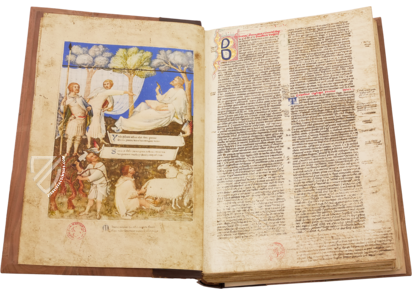Riccardiana Virgil - Bucolica, Georgica, Aeneid
(1,000€ - 3,000€)
The Riccardiana Virgil is a collected volume that contains the three main works of the Roman poet Virgil (70–19 BC): the pastoral poems of the Bucolica and the Georgica, and the Roman founding myth Aeneid. Now housed in the eponymous Biblioteca Riccardiana in Florence, the codex was commissioned around 1460 by the famous patron of the arts and Renaissance prince Lorenzo de' Medici (1449–92). It was written by Spinoso and artistically illuminated by the Florentine book artist Appolonio di Giovanni. The events of the three texts come to life in 88 colorful miniatures lavishly decorated with gold, some of which remained unfinished, which is the special charm of this manuscript. They give their modern beholders a rare glimpse behind the scenes of ancient book art. Moreover, the miniatures occasionally provide small impressions of 15th-century Florence by means of specific architectural depictions or reflections on political and social events.
Riccardiana Virgil - Bucolica, Georgica, Aeneid
The so-called Riccardiana Virgil is a true masterpiece of the great literature of the Latin poet Virgil. The manuscript contains the three main works of the poet, namely the Bucolica, Georgica, and the Aeneid, the Roman foundation myth. The illuminated codex was made at the behest of the Renaissance prince Lorenzo de Medici and is one of the most magnificent masterpieces stored today in the Riccardiana Library in Florence. The pages of the manuscript are illustrated with 88 staggering miniatures, numerous patterns in the borders, and excitingly adorned initials.
The Literature of Virgil
Virgil is unanimously celebrated today by experts as the most important author of Roman antiquity. His famous works in particular, the Bucolica (Eclogues), the Georgica, and the Aeneid, and their ideas revolutionized Latin literature. Shortly after his death, these were continuously copied, re-edited, commented on, and intertextually processed. The Roman national epic, the Aeneid, conveys the foundation myth and the pre-history of the founding of the city of Rome, processing the mythological fabrics from the Homeric epics of the Iliad and the Odyssey. The Eclogues or Bucolica, are a collection of ten pastoral poems that describe the life of Romans in the countryside in ancient times and the relationship of heads of state with their people. Similar themes were also addressed in the Georgica.
Interesting Book Art of the Renaissance
The miniatures of the manuscript are attributed to the Italian illuminators Apollonio di Giovanni and the staff of his artist studio. The astounding pictures show discernable influences from the political and social events of that time. For example, an image of people in oriental garments in the text section of the Aeneid is interpreted as a symbol for the fall of the Byzantine Empire in 1453. The splendid miniatures show the first-rate Florentine architecture of the Renaissance in the background, in front of which people bustle in eccentric clothes made of red and purple fabrics with embellishments of gold and silver. The pages of the text are decorated with numerous embellished initials in various sizes and designs. 19 of the total of 88 illustrations were not completed. These sketches and only partially-colored pictures gives the modern beholder a glimpse in the workings of the medieval illuminator and offers them an unforgettable journey through the art of the Renaissance.
Codicology
- Alternative Titles
- Virgilio Riccardiano
Virgilius opera. Bucolica, Georgica, Aeneid
Riccardiana-Vergil - Bucolica, Georgica, Aeneis
Riccardiano Virgil - Size / Format
- 512 pages / 30.5 × 20.0 cm
- Origin
- Italy
- Date
- Around 1460
- Epochs
- Style
- Genre
- Language
- Script
- Humanistic
- Illustrations
- 88 miniatures, 19 of them unfinished; white vine initials
- Content
- Complete text of the three great works of Publius Vergilius Maro (Bucoliche - Georgics - Aeneid)
- Patron
- Lorenzo I. de’ Medici (1449–1492)
- Artist / School
- Publius Vergilis Maro - Virgil (70–19 B.C.) (author)
Apollonio di Giovanni di Tommaso (1415 – 1465), also known as "Master of the Jarves Cassone" (illuminator)
Niccolò Riccio, known as Spinoso (scribe)
Riccardiana Virgil - Bucolica, Georgica, Aeneid
Aeneas’ Fleet is Wrecked in a Storm
Virgil begins his work with the Trojan fleet sailing in the eastern Mediterranean in search for a new home in Italy where it has been foretold that Aeneas will father a noble and courageous nation that will become known to all races. However, Juno is wrathful because she was not chosen in the Judgment of Paris and because her favorite city, Carthage, will be destroyed by the descendants of Aeneas. The vengeful goddess induces Aeolus, King of the Winds, to punish the Trojans with a storm.
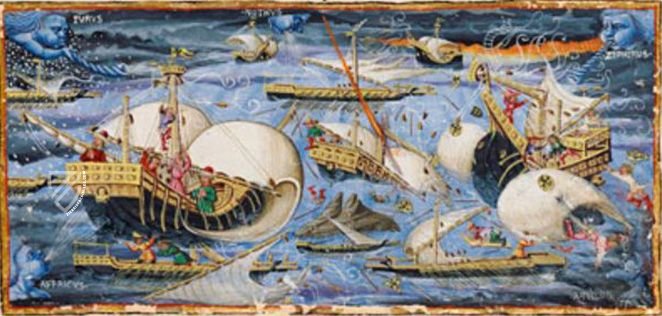
Riccardiana Virgil – Bucolica, Georgica, Aeneid
The Trojan Horse
This bas-de-page miniature shows the Trojans bringing the poisoned gift of the Greeks into the city gate in a panoramic landscape seen showing Troy’s mighty walls stretching off into the distance where fields can be seen. The figures are exaggerated in size, being nearly as tall as the horse, which is supposed to be filled with dozens of warriors.
This is a testimony to the skill of the great master Apollonio di Giovanni di Tommaso, who has transformed ancient Troy into Renaissance Florence. Dressed in the elaborate fashions of 15th century Italy, the figures are depicted with great realism, emphasizing the musculature of their legs and thighs. Everything is bathed in an incredibly rich color palette embellished with silver and gold.
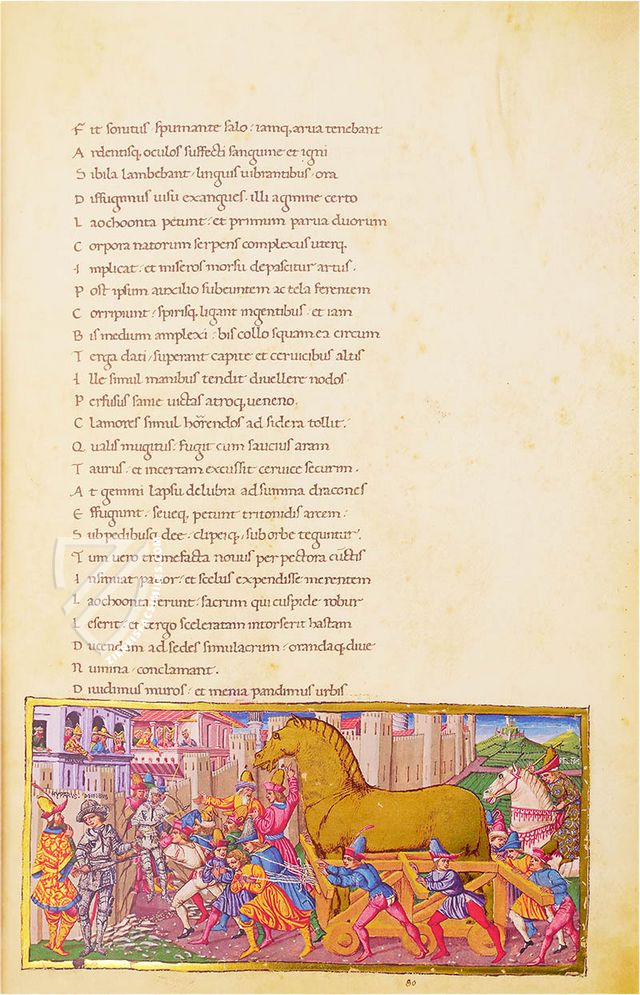
#1 Virgilio Riccardiano
Language: Italian
(1,000€ - 3,000€)
- Treatises / Secular Books
- Apocalypses / Beatus
- Astronomy / Astrology
- Bestiaries
- Bibles / Gospels
- Chronicles / History / Law
- Geography / Maps
- Saints' Lives
- Islam / Oriental
- Judaism / Hebrew
- Single Leaf Collections
- Leonardo da Vinci
- Literature / Poetry
- Liturgical Manuscripts
- Medicine / Botany / Alchemy
- Music
- Mythology / Prophecies
- Psalters
- Other Religious Books
- Games / Hunting
- Private Devotion Books
- Other Genres
- Afghanistan
- Armenia
- Austria
- Belgium
- Belize
- Bosnia and Herzegovina
- China
- Colombia
- Costa Rica
- Croatia
- Cyprus
- Czech Republic
- Denmark
- Egypt
- El Salvador
- Ethiopia
- France
- Germany
- Greece
- Guatemala
- Honduras
- Hungary
- India
- Iran
- Iraq
- Israel
- Italy
- Japan
- Jordan
- Kazakhstan
- Kyrgyzstan
- Lebanon
- Liechtenstein
- Luxembourg
- Mexico
- Morocco
- Netherlands
- Palestine
- Panama
- Peru
- Poland
- Portugal
- Romania
- Russia
- Serbia
- Spain
- Sri Lanka
- Sweden
- Switzerland
- Syria
- Tajikistan
- Turkey
- Turkmenistan
- Ukraine
- United Kingdom
- United States
- Uzbekistan
- Vatican City
- A. Oosthoek, van Holkema & Warendorf
- Aboca Museum
- Ajuntament de Valencia
- Akademie Verlag
- Akademische Druck- u. Verlagsanstalt (ADEVA)
- Aldo Ausilio Editore - Bottega d’Erasmo
- Alecto Historical Editions
- Alkuin Verlag
- Almqvist & Wiksell
- Amilcare Pizzi
- Andreas & Andreas Verlagsbuchhandlung
- Archa 90
- Archiv Verlag
- Archivi Edizioni
- Arnold Verlag
- ARS
- Ars Magna
- ArtCodex
- AyN Ediciones
- Azimuth Editions
- Badenia Verlag
- Bärenreiter-Verlag
- Belser Verlag
- Belser Verlag / WK Wertkontor
- Benziger Verlag
- Bernardinum Wydawnictwo
- BiblioGemma
- Biblioteca Apostolica Vaticana (Vaticanstadt, Vaticanstadt)
- Bibliotheca Palatina Faksimile Verlag
- Bibliotheca Rara
- Boydell & Brewer
- Bramante Edizioni
- Bredius Genootschap
- Brepols Publishers
- British Library
- C. Weckesser
- Caixa Catalunya
- Canesi
- CAPSA, Ars Scriptoria
- Caratzas Brothers, Publishers
- Carus Verlag
- Casamassima Libri
- Centrum Cartographie Verlag GmbH
- Chavane Verlag
- Christian Brandstätter Verlag
- Circulo Cientifico
- Club Bibliófilo Versol
- Club du Livre
- CM Editores
- Collegium Graphicum
- Collezione Apocrifa Da Vinci
- Comissão Nacional para as Comemorações dos Descobrimentos Portugueses
- Coron Verlag
- Corvina
- CTHS
- D. S. Brewer
- Damon
- De Agostini/UTET
- De Nederlandsche Boekhandel
- De Schutter
- Deuschle & Stemmle
- Deutscher Verlag für Kunstwissenschaft
- DIAMM
- Droz
- E. Schreiber Graphische Kunstanstalten
- Ediciones Boreal
- Ediciones Grial
- Ediclube
- Edições Inapa
- Edilan
- Editalia
- Edition Deuschle
- Edition Georg Popp
- Edition Leipzig
- Edition Libri Illustri
- Editiones Reales Sitios S. L.
- Éditions de l'Oiseau Lyre
- Editions Medicina Rara
- Editorial Casariego
- Editorial Mintzoa
- Editrice Antenore
- Editrice Velar
- Edizioni Edison
- Egeria, S.L.
- Eikon Editores
- Electa
- Emery Walker Limited
- Enciclopèdia Catalana
- Eos-Verlag
- Ephesus Publishing
- Ernst Battenberg
- Eugrammia Press
- Extraordinary Editions
- Fackelverlag
- Facsimila Art & Edition
- Facsimile Editions Ltd.
- Facsimilia Art & Edition Ebert KG
- Faksimile Verlag
- Feuermann Verlag
- Folger Shakespeare Library
- Franco Cosimo Panini Editore
- Friedrich Wittig Verlag
- Fundación Hullera Vasco-Leonesa
- G. Braziller
- Gabriele Mazzotta Editore
- Gebr. Mann Verlag
- Gesellschaft für graphische Industrie
- Getty Research Institute
- Giovanni Domenico de Rossi
- Giunti Editore
- Graffiti
- Grafica European Center of Fine Arts
- Guido Pressler
- Guillermo Blazquez
- Gustav Kiepenheuer
- H. N. Abrams
- Harrassowitz
- Harvard University Press
- Helikon
- Hendrickson Publishers
- Henning Oppermann
- Herder Verlag
- Hes & De Graaf Publishers
- Hoepli
- Holbein-Verlag
- Houghton Library
- Hugo Schmidt Verlag
- Idion Verlag
- Il Bulino, edizioni d'arte
- ILte
- Imago
- Insel Verlag
- Insel-Verlag Anton Kippenberger
- Instituto de Estudios Altoaragoneses
- Instituto Nacional de Antropología e Historia
- Introligatornia Budnik Jerzy
- Istituto dell'Enciclopedia Italiana - Treccani
- Istituto Ellenico di Studi Bizantini e Postbizantini
- Istituto Geografico De Agostini
- Istituto Poligrafico e Zecca dello Stato
- Italarte Art Establishments
- Jan Thorbecke Verlag
- Johnson Reprint Corporation
- Josef Stocker
- Josef Stocker-Schmid
- Jugoslavija
- Karl W. Hiersemann
- Kasper Straube
- Kaydeda Ediciones
- Kindler Verlag / Coron Verlag
- Kodansha International Ltd.
- Konrad Kölbl Verlag
- Kurt Wolff Verlag
- La Liberia dello Stato
- La Linea Editrice
- La Meta Editore
- Lambert Schneider
- Landeskreditbank Baden-Württemberg
- Leo S. Olschki
- Les Incunables
- Liber Artis
- Library of Congress
- Libreria Musicale Italiana
- Lichtdruck
- Lito Immagine Editore
- Lumen Artis
- Lund Humphries
- M. Moleiro Editor
- Maison des Sciences de l'homme et de la société de Poitiers
- Manuscriptum
- Martinus Nijhoff
- Maruzen-Yushodo Co. Ltd.
- MASA
- Massada Publishers
- McGraw-Hill
- Metropolitan Museum of Art
- Militos
- Millennium Liber
- Müller & Schindler
- Nahar - Stavit
- Nahar and Steimatzky
- National Library of Wales
- Neri Pozza
- Nova Charta
- Oceanum Verlag
- Odeon
- Orbis Mediaevalis
- Orbis Pictus
- Österreichische Staatsdruckerei
- Oxford University Press
- Pageant Books
- Parzellers Buchverlag
- Patrimonio Ediciones
- Pattloch Verlag
- PIAF
- Pieper Verlag
- Plon-Nourrit et cie
- Poligrafiche Bolis
- Presses Universitaires de Strasbourg
- Prestel Verlag
- Princeton University Press
- Prisma Verlag
- Priuli & Verlucca, editori
- Pro Sport Verlag
- Propyläen Verlag
- Pytheas Books
- Quaternio Verlag Luzern
- Reales Sitios
- Recht-Verlag
- Reichert Verlag
- Reichsdruckerei
- Reprint Verlag
- Riehn & Reusch
- Roberto Vattori Editore
- Rosenkilde and Bagger
- Roxburghe Club
- Salerno Editrice
- Saltellus Press
- Sandoz
- Sarajevo Svjetlost
- Schöck ArtPrint Kft.
- Schulsinger Brothers
- Scolar Press
- Scrinium
- Scripta Maneant
- Scriptorium
- Shazar
- Siloé, arte y bibliofilia
- SISMEL - Edizioni del Galluzzo
- Sociedad Mexicana de Antropología
- Société des Bibliophiles & Iconophiles de Belgique
- Soncin Publishing
- Sorli Ediciones
- Stainer and Bell
- Studer
- Styria Verlag
- Sumptibus Pragopress
- Szegedi Tudomànyegyetem
- Taberna Libraria
- Tarshish Books
- Taschen
- Tempus Libri
- Testimonio Compañía Editorial
- Thames and Hudson
- The Clear Vue Publishing Partnership Limited
- The Facsimile Codex
- The Folio Society
- The Marquess of Normanby
- The Richard III and Yorkist History Trust
- Tip.Le.Co
- TouchArt
- TREC Publishing House
- TRI Publishing Co.
- Trident Editore
- Tuliba Collection
- Typis Regiae Officinae Polygraphicae
- Union Verlag Berlin
- Universidad de Granada
- University of California Press
- University of Chicago Press
- Urs Graf
- Vallecchi
- Van Wijnen
- VCH, Acta Humaniora
- VDI Verlag
- VEB Deutscher Verlag für Musik
- Verlag Anton Pustet / Andreas Verlag
- Verlag Bibliophile Drucke Josef Stocker
- Verlag der Münchner Drucke
- Verlag für Regionalgeschichte
- Verlag Styria
- Vicent Garcia Editores
- W. Turnowski Ltd.
- W. Turnowsky
- Waanders Printers
- Wiener Mechitharisten-Congregation (Wien, Österreich)
- Wissenschaftliche Buchgesellschaft
- Wissenschaftliche Verlagsgesellschaft
- Wydawnictwo Dolnoslaskie
- Xuntanza Editorial
- Zakład Narodowy
- Zollikofer AG

